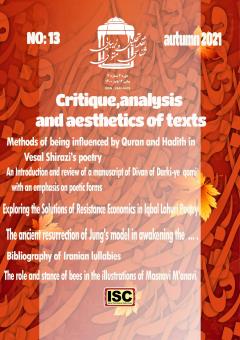Methods of being influenced by Quran and Hadith in Vesal Shirazi's poetry
Subject Areas : Analysis of order textsamir jahadi 1 , hamidreza kharazmi 2 , alireza khodavanddost 3
1 - Associate Professor of Persian Language and Literature , Faculty of Literature and Humanities, Shahid Bahonar University of Kerman
2 - Associate Professor of Persian Language and Literature , Faculty of Literature and Humanities, Shahid Bahonar University of Kerman
3 - Graduate Student of Persian Language and Literature, Shahid Bahonar University of Kerman
Keywords: Vesal Shirazi, Quran, Hadith, Manifestation of Quran and Hadith, Religious allusions.,
Abstract :
Mirza Mohammad Shafi Shirazi alias Vesal in the thirteenth century AH, a Muslim poet and a devout Shiite, is one of the lovers of the Ahl al-Bayt and one of the poets who in composing his poems on the verses of the Qur'an, narrations, hadiths and religious events and masterfully He has used his religious knowledge in his poetry with a fluent and eloquent nature. In this research, an attempt has been made to show the types of influences from the Quran and Hadith in the Divan of Vesal Shirazi. One of the important aspects of this research is that the methods of reflecting the hadiths and verses of the Qur'an in Wisal Divan have been highlighted and classified among a multitude of praiseworthy and descriptive poems. It also includes showing the reflection of religious beliefs in the court and the application of Quranic verses and hadiths and analyzes their frequency. The frequency of being influenced by the Qur'an and Hadith in Vesal's Divan in terms of poetic format is firstly assigned to his poems and then to his Masnavi, and in Vesal's sonnets, despite the high number, less influence is observed in this format; Also, Vesal has been influenced by the Qur'an and hadiths, who has taken advantage of this whenever he has a suitable opportunity and has done so in various ways; These include a special insistence on borrowing the words of the verses of the Qur'an, comparing them with verses and hadiths, and turning the audience's mind to the verses. The method considered in this research is a library method based on analysis and description of quantitative and qualitative content.
1. قرآن کریم
2. احمدی، مهدی و موسوی علیرضا. (1394). «بررسی جایگاه اهل بیت (ع) در شعر وصال شیرازی». مجلۀ علمی-پژوهشی زبان و ادبیات فارسی، دانشگاه آزاد اسلامی، واحد فسا، س6، ش2 (پیاپی 13). پاییز.
3. آقا جمال خوانسارى، محمّد بن حسين. (1366). شرح آقا جمال خوانسارى بر غرر الحكم و درر الكلم. تهران: دانشگاه تهران.
4. حلبی، علی اصغر. (1398). تأثیر قرآن و حدیث در ادبیات فارسی. تهران: اساطیر.
5. راستگو، سید محمّد. (1393). تجلّی قرآن و حدیث در شعر فارسی. تهران: سازمان مطالعه و تدوین کتب علوم انسانی دانشگاهها (سمت).
6. راشد محصّل، محمّدرضا. (1389). پرتوهایی از قرآن و حدیث در ادب فارسی. مشهد: آستان قدس رضوی.
7. شمس العلماء گرکانی. (1377). ابدع البدایع. به اهتمام حسین جعفری و با مقدمۀ دکتر جلیل تجلیل. تبریز: احرار.
8. قیس رازی، شمسالدّین محمّد. (1388). المعجم فی معاییر اشعار العجم. تهران: علم.
9. مجلسی، محمّد باقر. (1343). بحار الأنوار (ط_ بیروت). بیروت: دار إحیا التراث العربی.
10. محمّد ابن علی، ابن بابویه (شیخ صدوق). (366 هـ.ق). عیون اخبار الرضا. (ترجمۀ محمّد تقی آقا نجفی اصفهانی). (1297 هـ.ق). تهران: انتشارات علمیۀ اسلامیه.
11. معصوم شیرازی، محمّد. (1345). طرایق الحقایق. تهران: کتابخانه سنائی.
12. نهج الفصاحه. مجموعه کلام گهربار حضرت محمّد (ص). امید امیدی. نرم افزار.
13. وصال شیرازی، محمّد شفیع. (1378). دیوان کامل وصال شیرازی (2 جلدی). شیراز: نوید شیراز.
14. نصر بن مزاحم. (1382). وقعة الصفّین. تحقیق و شرح عبدالسلام محمّد هارون. قاهره: المؤسسة العربیة الحدیثة.
15. همایی، جلالالدّین. (1374). فنون بلاغت و صناعات ادبی. تهران: نشر هما.


